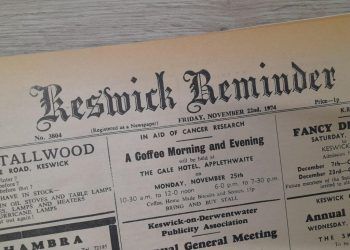The number of people in Keswick who are seeking work and claiming benefits rose by more than 100 last month, according to the latest government figures.
Keswick’s shock increase was the second highest of any ward in Cumbria as jobless totals across the county and beyond reached record highs because of the effects of the coronavirus lockdown.
The Lake District was worst hit area in Cumbria, with the number of people in the national park receiving Jobseeker Allowance or Universal Credit and actively available for work rising by 645 – a staggering increase of 297 per cent.
In Cumbria the claimant count rose by 81 per cent – that’s 5,595 – to 12,530 compared to the previous month. The UK rise was 67 per cent. Keswick’s increase of 115 was second only to Cumbrian wards at Windermere (130), followed by Kendal Town (105) and St Aidans (105) and Castle (105), both Carlisle. According to the 2011 census, the electoral ward of Keswick has a population of 5,243.
The increase in claimants in Cumbria is the highest both numerically and proportionally since data first became available for the county in January 1986. Even more alarmingly, the figures only go up to 9th April since when things have only got worse in terms of employment as most shops and all bars, restaurants and hotels remain closed.
Other headline figures for Cumbria showed the claimant rate had risen from 2.3 per cent to 4.2 per cent, which still leaves all areas of the county below the new national rate of 5.1 per cent. Numerically, South Lakeland (1,335), Carlisle (1,330) and Allerdale (1,035) saw the biggest increases, with South Lakeland (201%) having the biggest proportional rise after the Lake District national park – and the highest of all district authorities in England bar one.
Shane Byrne, partnership manager for the Department of Work and Pensions in Cumbria, said: “I am actually quietly confident about the future of the economy as lockdown eases and we start to reopen the county to people. The figures reflect people who have been furloughed and the self-employed, of which Cumbria has a high proportion.
“Obviously the tourism industry has been hit hard but there is also growth, with positions for delivery drivers, in warehouses and those in healthcare available. I believe there will be a bounce back and as the next few weeks unfold, we will be using our expertise and working with our partners to continue to support people – the next challenge is those who are at risk of redundancy following the lockdown.”
The picture in Cumbria last month was even worse when considering the number of Universal Credit claimants, including those not required to seek work and those claiming while in work, which was 28,441, a rise of 8,659 (44 per cent) from March. The biggest percentage increase was again in the Lake District national park (120 per cent) compared to a national rise of 40 per cent.
The Lake District also had the highest fall in job postings (-88 per cent) followed by Allerdale (-74 per cent), driven largely by a large fall in postings for the accommodation and food services sector (-91 per cent), which is a catastrophic drop for the tourist-driven Lakeland economy.
Government ministers tried to put a brave face on the figures. Mims Davies, minister for employment, said: “Clearly these figures are behind on our current struggle but the impact of this global health emergency is now starting to show – and we’re doing everything we can to protect jobs and livelihoods. What these statistics do highlight is that heading into the pandemic, we had built strong foundations in our economy, which will be crucial as we gradually move forward as the lockdown eases and look to bounce back.”
Will Quince, minister for welfare delivery, added: “We are extremely proud of our DWP (Department for Work and Pensions) colleagues who have worked flat out to ensure people get the support they need. Jobcentre staff have done a fantastic job of processing record numbers of Universal Credit claims and getting support to people who need it quickly.”








